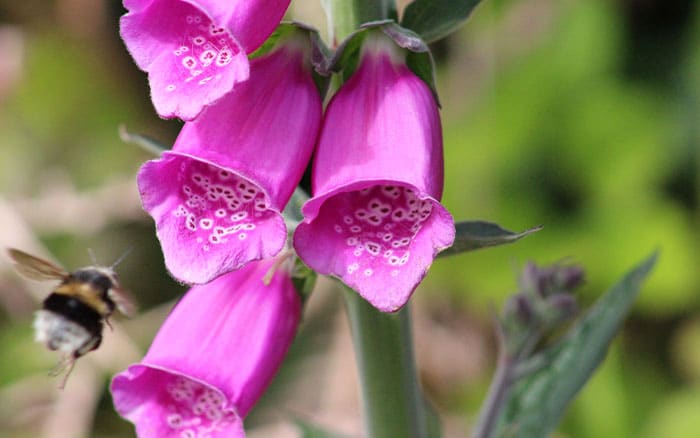Biennials are a great addition to garden planting schemes. Planting biennials among other plants is a great way of bringing a variety of colour and filling any gaps by planning ahead is a great idea.
What are biennials?

Unlike perennials that flower year after year and annuals that have a one-year life cycle, biennials have a two-year life cycle. In the first year the plants grow roots, stems, and leaves. Then, in the second year the plants come into flower, before producing seeds and dying.
Due to them not flowering in the first year, it’s great to plant them among perennials. Alternatively, plant other biennials in the year that the first biennials are coming into flower to ensure continuous flowering.
Biennials are great because many of them self-seed so there will be new plants.
1. Angelica sylvestris (wild angelica)
This architectural plant is a great low-maintenance choice that grows up to 2.5m tall. In the first year, the plant produces rosettes of foliage with purple stems. Then, the deeply coloured stems are topped with umbels of inflorescences.
- Flowers in summer
- Hardy
- Grows up to 2.5m tall
- Moist but well-drained or poorly-drained
- Full sun
- Exposed or sheltered

2. Eryngium giganteum (Miss Willmott’s ghost)
Without a doubt, this will add texture to your borders with the spiny leaves and umbels of blue-silver flowers and silvery bracts. As well as looking striking in many garden styles including coastal gardens, they also look fantastic as cut flowers.
- Flowers in summer
- Fully hardy
- Grows up to 1m tall
- Well-drained
- Full sun
- Exposed or sheltered

3. Oenothera biennis (common evening primrose)
The beautiful bowl-shaped yellow flowers that bloom in summer and autumn are a cheery addition to a border. The upright growing habit of this biennial will add height and texture to your garden, looking great in cottage and wildflower meadows.
- Flowers in summer
- Fully hardy
- Grows up to 1.5m tall
- Well-drained
- Full sun or partial shade
- Sheltered

4. Erysimum x marshallii (wallflower) ‘Orange Monarch’
Popular with pollinators, the flowers in late spring bring a fiery warm colour to the borders. As well as growing in the ground, they are well suited to growing in containers to add some bold colour to the display.
- Flowers in spring
- Hardy
- Grows up to 50cm tall
- Moist but well-drained
- Full sun
- Exposed or sheltered

5. Dianthus barbatus (sweet William)
Pretty pink to deep red flowers bloom on flattened heads in springtime, that are well-visited by bees. Growing best in a loamy or sandy soil, they need a well-drained soil to thrive. Although this is technically a short lived perennial, they tend to be grown as a biennial, with seeds sown in summer ready for flowers the following year.
- Flowers in spring
- Fully hardy
- Grows up to 50cm tall
- Well-drained soil
- Full sun
- Sheltered

6. Digitalis purpurea (white-flowered foxglove) ‘Alba’
Cottage garden favourites, these fabulous flowers will add towering height with their flower spires. Another popular pick for pollinators, they will grow well in any well-drained soil type. Their upright flowers look striking in many different planting locations including banks and slopes, underplanting of shrubs, and prairie planting.
- Flowers in summer
- Fully hardy
- Grows up to 1.5m tall
- Moist but well-drained soil
- Full sun or partial shade
- Exposed or sheltered

7. Myosotis sylvatica (forget-me-not) ‘Bluesylva’
Next is a low growing and spreading biennial with dense growth of green-grey foliage that’s joined by instantly recognisable forget-me-not flowers. Their size and bushy growth makes them a good choice for container plants.
- Flowers in spring
- Fully hardy
- Grows up to 50cm tall
- Moist but well-drained soil
- Full sun or partial shade
- Exposed or sheltered

8. Lunaria annua (honesty)
These can either be annual or biennial plants. In late spring, clusters of purple flowers bloom to accompany the heart-shaped leaves. But the show continues after flowering with silvery seed pods in autumn that add some real interest later in the season.
- Flowers in spring
- Full hardy
- Grows up to 1m tall
- Moist but well-drained soil
- Full sun or partial shade
- Exposed or sheltered

9. Verbascum nigrum (dark mullein)
The slim spikes of yellow flowers are sure to add some joy to your beds and borders. The yellow flowers have a purple centre that contrasts beautifully to give them more depth. The flowers can grace your garden from May until September.
- Flowers in summer
- Fully hardy
- Grows up to 1m tall
- Well-drained soil
- Full sun
- Exposed or sheltered

10. Glaucium flavum (yellow horned poppy)
Last is a short-lived perennial that is usually grown as a biennial. These drought-resistant plants will put on a show in summer with the yellow poppy flowers which are then followed by seed pods.
- Flowers in summer
- Hardy through most of the UK
- Grows up to 1m tall
- Well-drained soil
- Full sun
- Exposed or sheltered


Leave A Comment